What Are the Four Main Phases of the Moon? How Long Does It Take to Change From One to Another?
Half of the Moon's surface is always illuminated by sunlight. However, just how much of that light we can see from our point of view on Earth varies every day and this is what we refer to as a Moon phase.
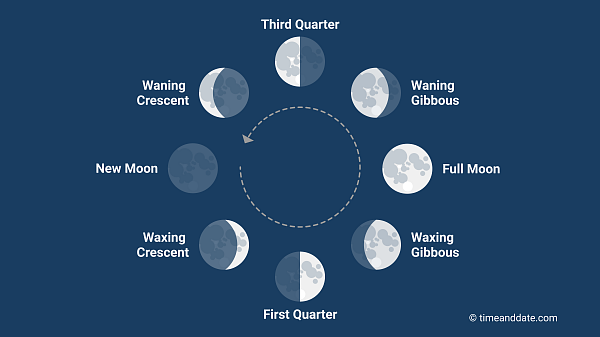

The eight phases of the Moon.
©timeanddate.com
Sun Lights Up the Moon
The Moon does not radiate its own light, but the Moon's surface reflects the Sun's rays.
Primary and Intermediate Phases
In Western Culture, we divide the lunar month into four primary and four intermediate Moon phases.
Technically, the primary Moon phases occur at a specific moment in time, and the intermediate Moon phases take up the time in between.
Opposite phases on the far side of the Moon
New Moon
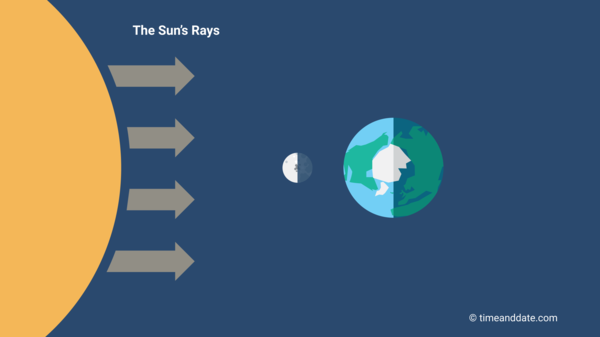

The Moon's position in space at New Moon.
©timeanddate.com
New Moon is the first primary phase and it occurs the moment when the Sun and Moon are aligned, with the Sun and Earth on opposite sides of the Moon.
A New Moon cannot normally be seen from Earth since only the dark side of the Moon faces our planet at this point. Sometimes, if the New Moon is close to the Lunar nodes of its path, it can cause a Solar Eclipse.
The greatest difference between high and low tide, also known as spring tides, takes place around New Moon and Full Moon.
The Moon: Our natural satellite
Waxing Crescent Moon
The moment a thin sliver of the Moon becomes visible after New Moon is the beginning of the first intermediate phase, the Waxing Crescent Moon.
In the past, this used to be called New Moon while the darkest phase was called Dark Moon. This traditional definition of New Moon is still in use in some cultures, defining the beginning of the months for instance in the Islamic calendar.
The rest of the Moon is also sometimes faintly visible during most of this phase because Earth also reflects sunlight onto the Moon. This phenomenon is called earthshine or Da Vinci glow, and it is most noticeable in April and May.
First Quarter Moon
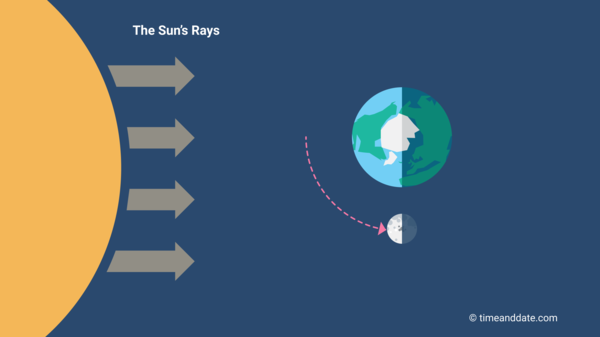

First Quarter Moon is the second primary phase.
©timeanddate.com
First Quarter Moon is the second primary Moon phase and it is defined as the moment the Moon has reached the first quarter of its orbit around Earth, hence the name. It is also called Half Moon as we can see exactly 50% of the Moon's surface illuminated. Whether you see the left or right half illuminated, depends on several factors, including your location.
The smallest difference between high and low tide, also known as neap tides, occurs around the 2 Quarter Moons.
Waxing Gibbous Moon
The second intermediate phase, the Waxing Gibbous Moon, lasts until the next primary phase. Waxing means that it is getting bigger. Gibbous refers to the shape, which is larger than the semicircle shape of the Moon at First Quarter, but smaller than a full circle.
Full Moon
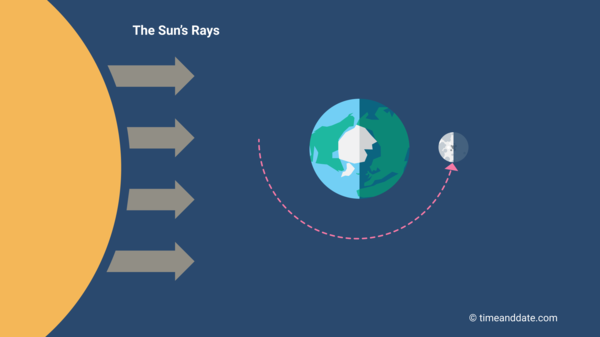

Full Moon is the brightest phase.
©timeanddate.com
The Full Moon appears in the night sky when the Sun and the Moon are aligned on opposite sides of Earth.
How can Full Moon be in the daytime?
Technically, this alignment only lasts a moment. However, the Moon can appear to be full a day before or after while more than 98% of the Moon's disc is illuminated.
When a Full Moon occasionally passes through Earth's shadow, it will cause a lunar eclipse.
When the Full Moon comes close to the points of its orbit that are closest or farthest away from Earth, we call it a Supermoon or Micromoon, respectively.
What is the Moon Illusion?
Waning Gibbous Moon
The next intermediate Moon phase is the Waning Gibbous Moon. The portion of the visible half of the Moon illuminated decreases during this period.
Third Quarter Moon
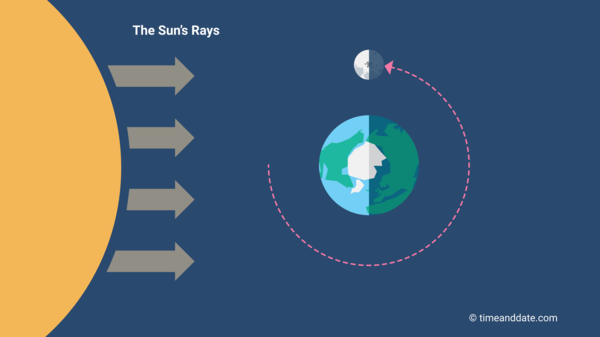

Third Quarter Moon is the last primary phase.
©timeanddate.com
The Third Quarter Moon occurs the moment the opposite half of the Moon is illuminated compared to the First Quarter Moon.
Waning Crescent Moon
The Sun illuminates less than half of the visible part of the Moon during the Waning Crescent Moon phase and you can sometimes see earthshine on the rest of the Moon towards the end.
Topics: Astronomy, Moon
What Are the Four Main Phases of the Moon? How Long Does It Take to Change From One to Another?
Source: https://www.timeanddate.com/astronomy/moon/phases.html
0 Response to "What Are the Four Main Phases of the Moon? How Long Does It Take to Change From One to Another?"
Post a Comment